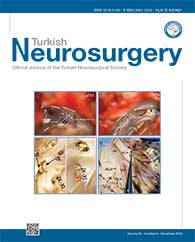2Gelisim University, College of Health Sciences, Istanbul, Turkey
3Arel University, Faculty of Medicine, Istanbul, Turkey DOI : 10.5137/1019-5149.JTN.44032-23.2 AIM: To examine the outcomes of microsurgery only versus combined microsurgery and embolization in treating cerebral arteriovenous malformations (AVM).
MATERIAL and METHODS: A total of 62 patients (34 male and 28 female) with Spetzler?Martin grade 3 (n=44) and grade 4 (n=18) AVMs were examined. Thirty-seven patients were treated with a combination of microsurgery + embolization, whereas 25 patients were treated with microsurgery alone. The clinical characteristics of the treatment groups were compared (ruptured/unruptured, eloquent/non-eloquent, modified Rankin scores, duration of surgery, preoperative and postoperative hemoglobin levels, and use of blood products).
RESULTS: The number of patients with ruptured or eloquently localized AVMs was more in combination of microsurgery + embolization. On the other hand, the duration, preoperative versus postoperative hemoglobin levels, and usage of blood products did not differ between treatment groups.
CONCLUSION: The results of the study showed no superiority of the combined treatment in managing AVMs in parallel to recent meta-analyses. However, a patient-tailored approach is recommended while making the treatment decision for such challenging intracerebral AVM cases.
Keywords : Arteriovenous malformation, Intracerebral, Embolization, Microsurgery




